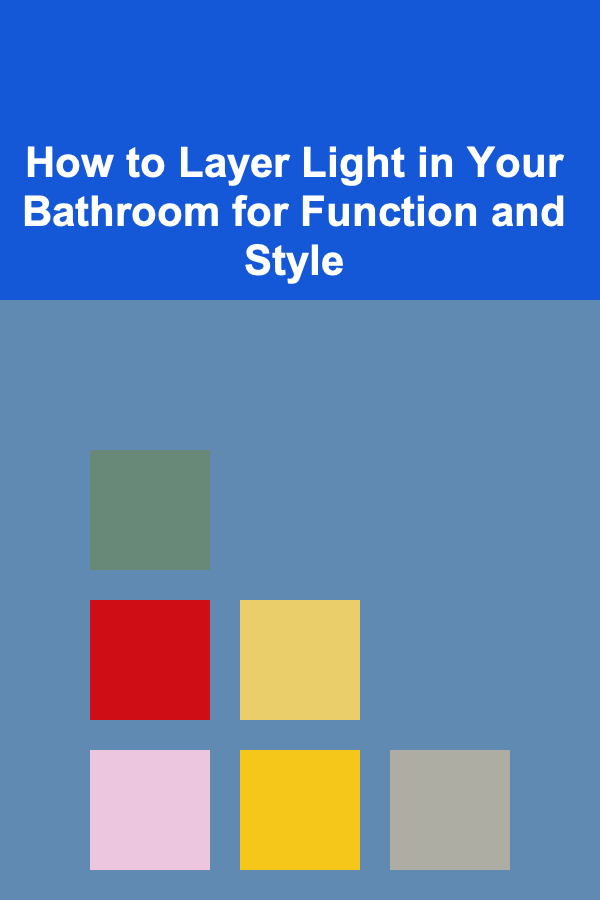
How to Layer Light in Your Bathroom for Function and Style
ebook include PDF & Audio bundle (Micro Guide)
$12.99$7.99
Limited Time Offer! Order within the next:

Lighting is one of the most critical aspects of bathroom design, but it is often overlooked or treated as an afterthought. A bathroom is a space where functionality and style need to come together seamlessly. Proper lighting enhances the space's usability, creating a comfortable, visually appealing, and practical environment for daily routines such as grooming, bathing, and relaxing. Layering light in the bathroom is essential to achieve both of these goals.
This article will explore how to layer light in your bathroom effectively, combining the right types of lighting to create a space that is well-lit, functional, and stylish. We'll break down the three primary layers of bathroom lighting --- ambient, task, and accent --- and discuss how to implement them based on your bathroom's layout, size, and aesthetic preferences.
The Importance of Proper Bathroom Lighting
Bathrooms require more lighting than many people realize. Unlike other spaces in the home, where natural light and general fixtures might suffice, the bathroom demands versatility due to the range of activities that occur within it. The right lighting design can provide a relaxing ambiance for unwinding in the tub or shower, and bright, focused light for precise tasks like shaving or applying makeup.
Layering light properly ensures that all areas are illuminated based on their specific purpose. Whether you're getting ready in the morning, unwinding in the evening, or performing delicate skincare routines, having the correct lighting layers can significantly impact your comfort and effectiveness.
The Three Layers of Bathroom Lighting
In the same way that different furniture pieces and colors create harmony in a room, lighting layers work together to provide the correct atmosphere and functionality. When layering light in the bathroom, we generally focus on three key layers:
1. Ambient Lighting: The Foundation of Bathroom Lighting
Ambient lighting serves as the primary light source in a bathroom. It provides general illumination to ensure the entire room is lit evenly. Ambient light should fill the room with a soft, uniform glow, eliminating harsh shadows and dark corners.
How to Achieve Effective Ambient Lighting
The most common way to achieve ambient lighting in the bathroom is through overhead light fixtures, which distribute light evenly throughout the space. Here are a few options:
- Ceiling-mounted Fixtures: Flush-mount ceiling lights are a great choice for bathrooms of all sizes. They provide even coverage across the entire room and work well in spaces with lower ceilings, ensuring the light doesn't feel overpowering or intrusive.
- Recessed Lighting: Recessed ceiling lights are ideal for a sleek, minimalist look. These lights sit flush against the ceiling, making them a perfect choice for bathrooms where you don't want the fixture to stand out. Multiple recessed lights can be spaced evenly around the room to create a balanced, soft glow.
- Chandeliers or Pendant Lights: If your bathroom has a larger or more luxurious feel, a statement chandelier or pendant light can serve as the primary ambient light source. These fixtures not only provide general illumination but also act as a design focal point, adding a touch of elegance or drama to the space.
- Skylights and Windows: Natural light should also be factored into your ambient lighting design. If your bathroom has a skylight or windows, strategically placing these features allows daylight to fill the space, reducing the need for artificial lighting during the day.
2. Task Lighting: For Precision and Practicality
Task lighting is crucial for specific functions in the bathroom, such as applying makeup, shaving, and brushing teeth. This layer of lighting provides focused, bright illumination where it's needed the most. Task lighting must be bright enough to allow you to perform detailed activities without straining your eyes or creating shadows.
How to Achieve Effective Task Lighting
Task lighting should be positioned where it is most needed --- typically around the mirror, shower, or tub area. Below are some ideal ways to implement task lighting in your bathroom:
-
Vanity Lighting: When it comes to grooming tasks, the bathroom vanity is the focal point. Lights around the mirror should be positioned at eye level to reduce shadows and provide an even distribution of light on your face. Consider placing sconces or light bars on either side of the mirror for balanced, flattering illumination. Avoid overhead lighting directly above the mirror, as this can cast unflattering shadows on your face.
-
Wall-mounted Sconces: Install sconces on either side of the mirror to create even, shadow-free lighting. Sconces should be installed approximately 60-70 inches from the floor and at least 30 inches apart to prevent shadows and provide balanced light.
-
Light Bars or Strip Lights: Another excellent option for vanity lighting is a light bar or strip, which can be mounted above the mirror. These provide bright, focused light and are ideal for bathrooms with limited space for wall-mounted fixtures.
-
-
Shower Lighting: When it comes to shower lighting, you need fixtures that can withstand moisture and humidity. Recessed lights, often rated for wet or damp locations, are ideal for this purpose. A bright, focused light will ensure that the entire shower area is illuminated, making it easier to see when performing tasks like washing your hair or body.
-
Overhead Fixtures for Task Areas: If your bathroom layout requires overhead lighting to perform tasks, make sure the fixture provides enough brightness to illuminate specific areas. In larger bathrooms, consider using multiple focused light sources to cover different zones, such as the bathtub, shower, or grooming area.
3. Accent Lighting: Adding Style and Drama
Accent lighting is all about enhancing the visual appeal of your bathroom. It creates depth and highlights the room's architecture, design elements, and decorative features. Accent lighting isn't essential for functionality but adds a layer of visual interest and mood to the space.
How to Achieve Effective Accent Lighting
Accent lighting in the bathroom is typically used to highlight particular features like artwork, architectural details, or shelving. Here are some ways to incorporate accent lighting into your bathroom:
- Under-cabinet Lighting: Under-cabinet lighting can be a subtle but effective way to add ambiance and visual depth to your bathroom. These lights can illuminate shelves, add a soft glow to the floor, and create a cozy, inviting atmosphere at night. They also help highlight any decorative pieces you may have on display.
- Backlighting Mirrors: Backlighting your bathroom mirror adds a luxurious touch and creates a soft halo effect around the glass. This technique enhances the mirror's visibility while offering a soft, ambient glow, ideal for those times when you want a more relaxed vibe in the bathroom.
- Recessed Accent Lights: Install recessed lights in the ceiling or walls to spotlight features like a statement bathtub or decorative shelving. This method can draw attention to your favorite design elements, such as elegant tiles, sculptures, or artwork.
- Track Lighting: If your bathroom has distinctive architectural elements you want to highlight, track lighting can provide flexibility in directing light exactly where you need it. You can aim the track lights at mirrors, artwork, or other focal points to create visual drama.
Choosing the Right Lighting Fixtures for Your Bathroom
Choosing the right fixtures for your bathroom lighting layers is essential for achieving the desired effect. Consider the size, design, and functionality of your space before selecting fixtures. Below are some options to consider for each layer of lighting:
Ambient Lighting Fixtures
- Flush Mount Ceiling Lights: Ideal for smaller bathrooms or bathrooms with low ceilings, flush mount lights provide unobtrusive, even lighting.
- Pendant Lights: Great for larger bathrooms with higher ceilings, pendant lights can act as a statement piece while providing general illumination.
- Recessed Lights: Sleek and minimal, recessed lights are perfect for a modern bathroom design and can be used to provide consistent ambient lighting.
Task Lighting Fixtures
- Wall-mounted Sconces: Positioned at eye level, sconces on either side of the mirror provide even illumination without casting shadows.
- Vanity Light Bars: Mounted above the mirror, vanity light bars offer bright and focused light, perfect for grooming.
- Shower-Specific Fixtures: Recessed lighting rated for damp or wet locations is ideal for the shower area, ensuring adequate light for showering tasks.
Accent Lighting Fixtures
- LED Strip Lighting: Flexible and energy-efficient, LED strip lights can be installed under shelves, vanities, or along the perimeter of the ceiling to add warmth and ambiance.
- Track Lighting: Track lights can be directed toward specific features, such as artwork or decorative tiles, enhancing the overall aesthetic of the bathroom.
- Backlit Mirrors: Modern and stylish, backlit mirrors not only provide task lighting but also add a sophisticated touch to your bathroom's design.
Final Thoughts on Layering Light in the Bathroom
Layering light in your bathroom is crucial for both functionality and style. By combining ambient, task, and accent lighting, you can create a space that is well-lit for daily routines while also adding a sense of luxury and comfort. The key is to use the right type of lighting for each specific function and to balance brightness with warmth to create a space that feels inviting, relaxing, and functional.
By carefully planning and layering your lighting design, your bathroom can become more than just a functional space---it can be a personal retreat where you enjoy your daily rituals in style. Whether you're remodeling an existing bathroom or designing a new one, consider the lighting layers and fixtures that best fit your space's needs and your design vision.
Reading More From Our Other Websites
- [Home Budget 101] How to Budget for Home Energy Costs: Save on Utilities This Winter
- [Home Family Activity 101] How to Plan a Family-Friendly DIY Spa Day
- [Organization Tip 101] How to Use Display Cases for Fragile Vintage Items
- [Organization Tip 101] How to Use Time Blocking to Optimize Your Workday
- [Organization Tip 101] How to Develop a Routine for Maintaining Bathroom Organization
- [Survival Kit 101] Essential Emergency Preparedness Kits: A Complete Guide to Survival
- [Home Soundproofing 101] How to Use Curtains to Soundproof Your Home Effectively
- [Gardening 101] The Benefits of Using Garden Compost for Sustainable Gardening
- [Home Cleaning 101] How to Tidy Up and Clean Your Home Before a Big Event
- [Organization Tip 101] How to Store and Organize Your Hose and Watering Equipment

Ace Your Next Job Interview: Common Questions and How to Answer Them
Read More
How to Choose the Right Investment Strategy for Beginners
Read More
How to Create a Dream Closet on a Budget
Read More
How to Use Real Estate as a Part of Your Financial Plan
Read More
10 Tips for Smart Home Technology Integration During Renovation
Read More
How to Build a Fitness Habit: A 30-Day To-Do List
Read MoreOther Products

Ace Your Next Job Interview: Common Questions and How to Answer Them
Read More
How to Choose the Right Investment Strategy for Beginners
Read More
How to Create a Dream Closet on a Budget
Read More
How to Use Real Estate as a Part of Your Financial Plan
Read More
10 Tips for Smart Home Technology Integration During Renovation
Read More